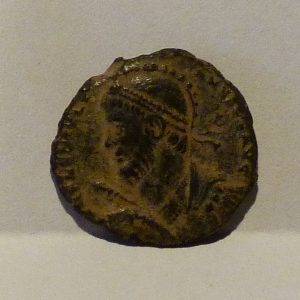Julian was born in 331AD. His father was Constantine the Greats nephew, and he was emperor Constantius’ cousin. Born into Christian family, whilst growing up he avoided purges within the family and buried himself in study, professing no interest in politics, gaining a reputation as brilliant student.
He secretly coverted from Christianity to paganism under tutleidge of Maximus of Ephesus, neoplatonic pholosopher, and was shown how to make special contract with gods using theurgic arts (whose central tenet is the belief that humans could control gods through intense study of divine world – based on Chaldean Oracles. Maximus had introduced him to the flaming and talking statue of the goddess Hecate. Another source says he was also initiaited into cults of Eleusis (which used plant based drug to cause hallucinations) and Mithraism,
Appointed Caesar by Constantius in 355, he was given control of Briton and Gaul, he fitted well into military life within a year had a well discipled fighting force.
This was a time of roving Goths (Alamanni) causing trouble. Julian won stunning victory near Strasbourg over Alamanni led by Chnodomar, the Goths lost 6000 men plus another 2000 drowned trying to re-cross Rhine, Chnodomar was captured and taken to Rome.
By 358 the emperor was suspcious that Julian was plotting to overthrow him, but the emperor was busy with troublesom Persians and theological discussions on the nature of the holy trinity
Early in 360 Julian sent some of his troops to Britian to help in campaigns against Caledonian Picts.
In March 360 some of the troops he was commanding in Gaul were to be transferred to the Persian front by command of Constantius, but instead they rebelled and proclaimed Julian emperor, he wrote to his cousin suggesting splitting the empire (east/west), Constantius, busy with the Persians agreed.
But in 361 Constantius died of a fever. Immediately after the burial of Constantius in Constantinople began to worship old gods openly.
He didn’t persecute Christians, but did try to sow discord, recalling exiled bishops that had held non-conformant doctrinal views. He did try to promote worship of old gods. Pagan centres across empire were restored.
Littlecote Villa was excavated under direction of Bryn Walters from 1978 to 1991.
The first Roman building on the site was started about 120, but had been preceded by circular huts and a temporary Roman military camp.
At about 170, the villa was rebuilt, including an integral bath suite. Over the year more chnages were made. Around 270 a new mosaic was commissioned by its owners, it has been interpreted as possibly a cult centre for the worship of Orpheus, Bacchus and Apollo, a coin found (not the one shown) dated the structure to reign of Julian.

Many of the buildings were demolished or fell into decay around 400, shortly after paganism was suppressed and before the Roman state left Britain. Two post Roman timber structures were found suggesting some ongoing occupation.
What of Julian? in 363 he attacked Persia, and on 26 June was mortally wounded, Jovian appointed emperor in his place. Julian was given the appelation “The Apostate”.


I do not understand the ‘label’ ‘Julian II’ on the coin photo which seems to suggest that there was a second Julian. I thought that there was only one Julian.
Well spotted, a mistake on my part, I’ve correted it now
Thanks Cassie. Alan